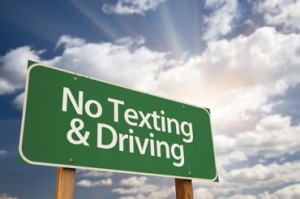 Driving is a complex task that requires your undivided attention. You might be focused on the task but what about other drivers? Accidents related to distracted driving are on the rise and the almighty cell phone is a major cause.
Driving is a complex task that requires your undivided attention. You might be focused on the task but what about other drivers? Accidents related to distracted driving are on the rise and the almighty cell phone is a major cause.
According to the National Safety Council cellphone-related auto accidents in the U.S. rose for the third straight year. Cellphone distractions account for more than one in four of those accidents. Its frightening to think that according to statistics those numbers may be under-reported.
The Center for Disease Control reported the following impact of distracted driving;
- In 2012, 3,328 people were killed in crashes involving a distracted driver compared to 3,360 in 2011. An additional, 421,000 people were injured in motor vehicle crashes involving a distracted driver in 2012, a 9 percent increase from the 387,000 people injured in 2011.
- In 2011, nearly one in five crashes (17 percent) in which someone was injured involved distracted driving.
The NSC estimates texting-related crashes rose from 5 percent to 6 percent while those involving talking on phones stayed at 21 percent for a total of 27 percent of the 5.7 million crashes in 2013.
NSC CEO Deborah A.P. Hersman said in a statement that, “While the public understands the risks associated with distracted driving, the data shows the behavior continues. We need better education, laws and enforcement to make our roads safer for everyone.”
Texting seems to have become a part of daily life. New research by psychologists from Penn State Harrisburg found that college students agree that it’s socially unacceptable to text while showering, on the toilet, eating, attending a funeral or while having sex, but do it anyway.
The results of the 70 question survey was published as “2 TXT or not 2 TXT: College students’ reports of when text messaging is social breach,” in the Social Science Journal.
Distracted driving, and operating other vehicles, has been listed as one of the top ten challenges by the National Transportation Safety Board. According to the NTSB, since 2003 distractions from portable electronic devices (PEDs) has been a cause or contributing factor in 11 accident investigations. Those crashes resulted in 259 people injured and 50 people killed. And the NTSB noted it does not investigate the majority of highway crashes.
The National Highway Traffic Safety Administration (NHTSA) reports hundreds of such deaths on our highways in 2012 alone. According to NHTSA, drivers engaging in visual-manual tasks, such as dialing or texting, triple their risk of a crash.
In a 2010 study conducted by Melvin Davis, Ph.D of the Mississippi Urban Research Center black and minority students are more likely to engage in cellphone activities while behind the whee of a car. The study revealed that;
- Black upperclassmen were more likely to talk on a cell phone.
- Freshmen were more likely to text while driving.
- Incoming calls were a significant predictor of crashes.
- Black students were twice as likely to have a crash when receiving incoming calls on their cell phone
Another study conducted by NHTSA revealed that while the rate of distracted driving is roughly equal among all ethnicities African-Americans were the highest with 43 percent of drivers prone to distraction.
Many states are reacting to the rise in cell phone distraction behind the wheel. These include bans on cellphone use behind the wheel. These include;
- Hand-held Cell Phone Use Ban: 14 states, D.C., Puerto Rico, Guam and the U.S. Virgin Islands prohibit all drivers from using hand-held cell phones while driving.
- All Cell Phone ban: No state bans all cell phone use for all drivers, but 37 states and D.C. ban all cell phone use by novice or teen drivers, and 20 states and D.C. prohibit any cell phone use for school bus drivers.
- Text Messaging ban: 46 states, D.C., Puerto Rico, Guam and the U.S. Virgin Islands ban text messaging for all drivers.
- 3 states prohibit text messaging by novice or teen drivers.
- 3 states restrict school bus drivers from texting.
While the cellphone is not only distraction while driving it is number one according to a combined study conducted by the NHTSA and the Virginia Tech Transportation Institute. The study ranks driver distractions in the following order’
Top 10 Driver Distractions (source: NHTSA-VTTI Study):
1. Using a wireless device, such as a cell phone
2. Talking to and interacting with passengers
3. Reaching for CDs, food, falling objects or other internal distractions
4. Programming radio stations or tinkering with dashboard controls
5. Using an electric razor, applying makeup or other personal hygiene-related actions
6. Unwrapping a burger, opening a canned drink or other movements when eating at the wheel
7. External distractions such as pointing out a funny billboard or pedestrian
8. Talking or singing to oneself
9. Smoking
10. Daydreaming
Being able to multi-task is great skill at work and home but driving a car carries the responsibility being in a constant life or death situation. PUT DOWN THE PHONE! DRIVE THE CAR!
Now you know.
